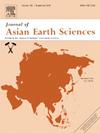Evidence of Paleo-Subduction along the Pranhita-Godavari Basin, India: Constraints from the joint interpretation of aeromagnetic and gravity data
IF 2.7
3区 地球科学
Q2 GEOSCIENCES, MULTIDISCIPLINARY
引用次数: 0
Abstract
Pranhita-Godavari (PG) Basin is an inter-cratonic failed rift basin between the Dharwar and Bastar cratons in the Southern Indian Shield. Previous studies reveal an unusually thick crust beneath it with high surface heat flow, a characteristic uncommon in inter-cratonic failed rift basins. To understand this uncommon phenomena, we carry out the aeromagnetic and Bouguer gravity data interpretation of the PG Basin constrained by seismic and seismological data. The Bouguer gravity anomaly highs on either side of the basin reflect crustal extension of the Karimnagar Granulite Belt (KGB) and Bhopalpatnam Granulite Belt (BGB). The Moho depth map, derived from constrained 3-D gravity inversion, shows depth variations between 35 and 47 km in the region. Additionally, the estimated Curie depths from aeromagnetic anomaly data vary between 22 and 30 km, with shallower depths (∼22–26 km) beneath the basin, and reconcile with the observed higher heat flow in the region. The crustal model reveals: i) a normal crustal thickness below the PG Basin; ii) a high-density lower crustal body (∼3.05 gm/cc) within the basin; iii) high-density, upper-mid crustal bodies interpreted as granulitic rocks (KGB and BGB) exhibit increased magnetisation at the margins of the PG basin. Both the KGB and BGB thicken with depth beneath the PG Basin before rapidly thinning-resembling boudinage beneath the basin depocenter. Both KGB and BGB represent once continuous package of granulite rocks. The thinning of granulite package is related to crustal thinning associated with rift formation and the development of PG Basin.
求助全文
约1分钟内获得全文
求助全文
来源期刊

Journal of Asian Earth Sciences
地学-地球科学综合
CiteScore
5.90
自引率
10.00%
发文量
324
审稿时长
71 days
期刊介绍:
Journal of Asian Earth Sciences has an open access mirror journal Journal of Asian Earth Sciences: X, sharing the same aims and scope, editorial team, submission system and rigorous peer review.
The Journal of Asian Earth Sciences is an international interdisciplinary journal devoted to all aspects of research related to the solid Earth Sciences of Asia. The Journal publishes high quality, peer-reviewed scientific papers on the regional geology, tectonics, geochemistry and geophysics of Asia. It will be devoted primarily to research papers but short communications relating to new developments of broad interest, reviews and book reviews will also be included. Papers must have international appeal and should present work of more than local significance.
The scope includes deep processes of the Asian continent and its adjacent oceans; seismology and earthquakes; orogeny, magmatism, metamorphism and volcanism; growth, deformation and destruction of the Asian crust; crust-mantle interaction; evolution of life (early life, biostratigraphy, biogeography and mass-extinction); fluids, fluxes and reservoirs of mineral and energy resources; surface processes (weathering, erosion, transport and deposition of sediments) and resulting geomorphology; and the response of the Earth to global climate change as viewed within the Asian continent and surrounding oceans.
 求助内容:
求助内容: 应助结果提醒方式:
应助结果提醒方式:


